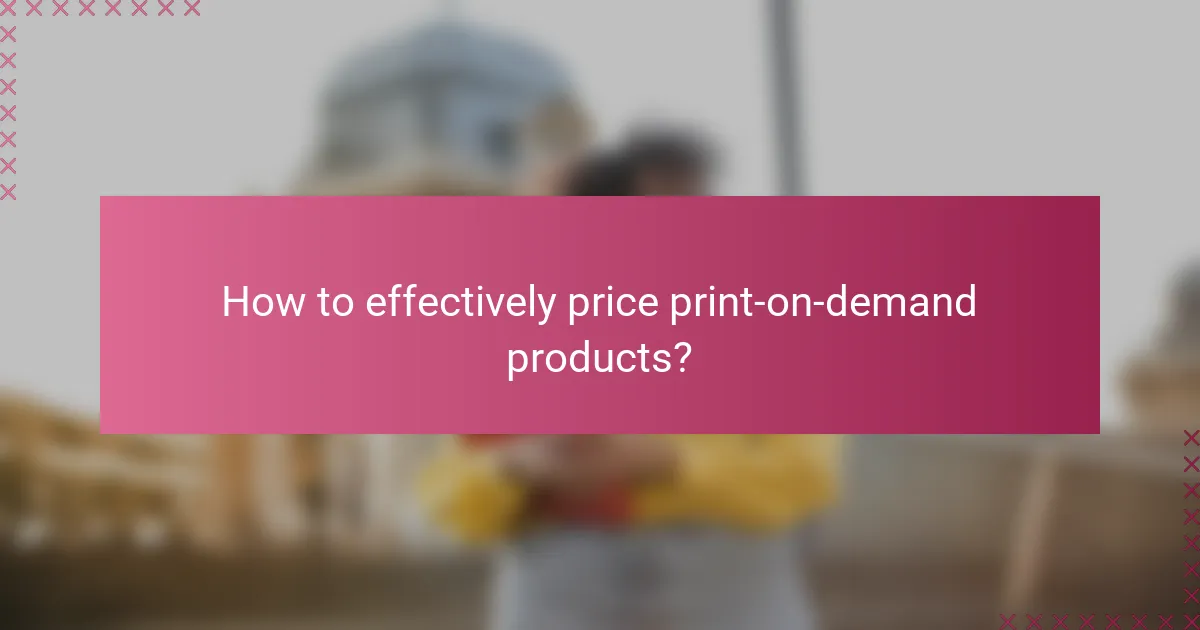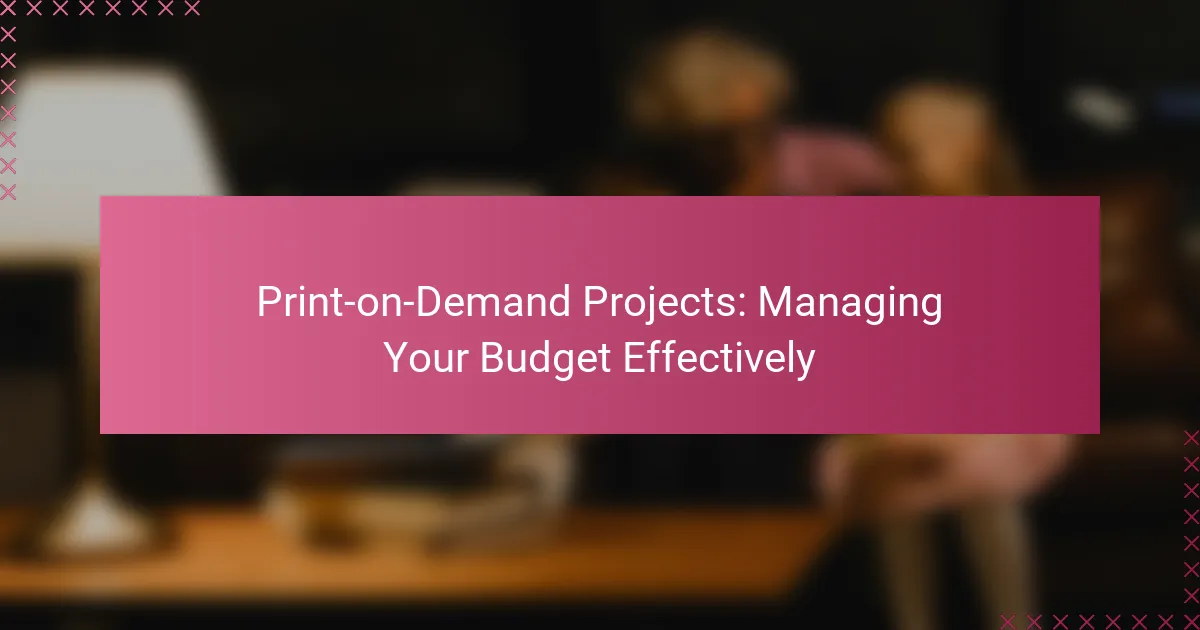Effectively managing your budget for print-on-demand projects is crucial for maximizing profitability and minimizing unexpected costs. By setting clear financial limits and tracking your expenses, you can make informed decisions that align with your business goals. Additionally, selecting the right products and platforms tailored to your needs can further enhance your financial strategy.

How to manage your budget for print-on-demand projects?
Managing your budget for print-on-demand projects involves setting clear financial limits, tracking expenses, and adjusting strategies based on cost analysis. By implementing effective budgeting practices, you can maximize profitability while minimizing unexpected costs.
Set a clear budget limit
Establishing a clear budget limit is essential for any print-on-demand project. Determine how much you can afford to spend on production, marketing, and other related expenses before you start. This helps prevent overspending and keeps your project financially viable.
Consider factors such as your target audience, expected sales volume, and potential profit margins when setting your budget. A common approach is to allocate a specific percentage of your expected revenue to production costs, often ranging from 20% to 40%.
Track expenses using software
Utilizing budgeting software can streamline the tracking of expenses for your print-on-demand projects. Tools like QuickBooks, FreshBooks, or even simple spreadsheets can help you monitor costs in real-time, making it easier to stay within your budget.
Regularly update your expense records and categorize them by type, such as production, shipping, and marketing. This will provide insights into where your money is going and help identify areas where you can cut costs.
Analyze cost per item
Understanding the cost per item is crucial for pricing your products effectively. Calculate all associated costs, including materials, labor, and shipping, to determine the total expense for each item produced. This analysis helps ensure that your pricing covers costs and generates profit.
As a rule of thumb, aim for a markup that allows for at least a 30% profit margin after covering all expenses. Regularly review these calculations as costs may fluctuate due to supplier changes or market conditions.
Adjust pricing strategies
Adjusting your pricing strategies can significantly impact your budget management. Consider implementing tiered pricing, where you offer discounts for bulk purchases, or seasonal promotions to boost sales during peak times.
Additionally, keep an eye on competitors’ pricing to ensure your products remain attractive. If necessary, be prepared to adjust your prices based on changes in production costs or market demand.
Utilize bulk order discounts
Taking advantage of bulk order discounts can lead to substantial savings in your print-on-demand projects. Many suppliers offer lower rates for larger orders, which can significantly reduce your cost per item.
Evaluate your sales forecasts to determine if ordering in bulk is feasible. If you anticipate high demand for certain products, placing larger orders can enhance your profit margins while ensuring you have sufficient stock on hand.

What are the best platforms for print-on-demand?
The best platforms for print-on-demand (POD) vary based on specific needs such as integration, marketing, artist support, and product variety. Each platform offers unique features that cater to different aspects of managing a POD business effectively.
Printful for integration options
Printful excels in providing seamless integration with various e-commerce platforms like Shopify, WooCommerce, and Etsy. This flexibility allows users to easily connect their online stores and automate order fulfillment, which can save significant time and effort.
Consider using Printful if you prioritize a streamlined workflow. Their user-friendly interface and extensive documentation make it easier for beginners to set up and manage their POD projects efficiently.
Teespring for marketing tools
Teespring, now known as Spring, offers robust marketing tools designed to help creators promote their products effectively. With features like social media integration and customizable storefronts, users can easily reach their target audience and boost sales.
If marketing is a key focus for your POD business, Teespring’s built-in promotional features can be invaluable. Utilize their analytics to track performance and adjust your strategies accordingly for better results.
Redbubble for artist support
Redbubble is particularly known for its strong support of independent artists and creators. The platform provides a community-driven marketplace where artists can showcase their designs on a wide range of products, from apparel to home decor.
For artists looking to gain exposure, Redbubble offers tools to help promote their work and connect with potential buyers. This platform is ideal for those who want to focus on creativity while benefiting from a built-in audience.
Gooten for product variety
Gooten stands out for its extensive product variety, offering a wide range of items that can be customized, including clothing, accessories, and home goods. This diversity allows sellers to cater to different customer preferences and expand their product lines easily.
When choosing Gooten, consider the potential for upselling by offering unique products that competitors may not have. Their platform also supports integration with various e-commerce sites, making it a flexible option for POD businesses.

How to choose products that maximize profit?
Choosing products that maximize profit involves selecting items with high demand and favorable profit margins while considering market trends and competition. Focus on products that not only sell well but also offer a reasonable return on investment.
Research trending items
Identifying trending items is crucial for maximizing profit in print-on-demand projects. Utilize tools like Google Trends, social media platforms, and e-commerce marketplaces to discover what products are currently popular among consumers.
Look for items that have a growing interest over time, as these trends can indicate potential profitability. For instance, seasonal designs or niche markets can yield high returns if timed correctly.
Evaluate profit margins
To ensure profitability, evaluate the profit margins of potential products. Calculate the cost of production, including materials and shipping, and compare it to the selling price to determine your margin.
A healthy profit margin typically ranges from 20% to 50%, depending on the product type. Avoid items with low margins, as they may not cover operational costs or marketing expenses effectively.
Consider seasonal demand
Seasonal demand can significantly impact product profitability. Certain items may sell exceptionally well during specific times of the year, such as holidays or events, while others may have consistent year-round sales.
Plan your inventory and marketing strategies around these seasonal trends. For example, create holiday-themed designs in advance to capitalize on increased demand during peak shopping seasons.
Analyze competitor offerings
Understanding what competitors offer can provide insights into market gaps and pricing strategies. Analyze their product range, pricing, and customer reviews to identify strengths and weaknesses.
Use this information to differentiate your products by offering unique designs or better pricing. Consider using tools like SEMrush or Ahrefs to gather data on competitor performance and optimize your own offerings accordingly.

What are the common pitfalls in budgeting for print-on-demand?
Common pitfalls in budgeting for print-on-demand include underestimating costs, ignoring potential delays, and overlooking marketing expenses. Each of these factors can significantly impact your overall budget and profitability.
Underestimating shipping costs
Shipping costs can vary widely based on factors such as destination, weight, and shipping method. Many entrepreneurs fail to account for these variables, leading to unexpected expenses that can erode profits. It’s advisable to research shipping rates from multiple carriers and factor in additional costs like customs duties for international orders.
To avoid underestimating shipping costs, consider using a shipping calculator or tools provided by your print-on-demand partner. This can help you estimate shipping fees accurately and include them in your pricing strategy.
Ignoring production delays
Production delays can occur due to high demand, equipment issues, or supply chain disruptions. Ignoring these potential setbacks can result in missed deadlines and dissatisfied customers. It’s crucial to build buffer time into your project timelines to accommodate unforeseen delays.
To manage production delays effectively, maintain open communication with your print-on-demand provider. Regular updates on production status can help you adjust your marketing and sales strategies accordingly.
Overlooking marketing expenses
Marketing expenses are often underestimated or neglected in the budgeting process. While print-on-demand services handle production, you are responsible for promoting your products, which can involve costs for advertising, social media campaigns, and influencer partnerships. Failing to allocate a budget for marketing can limit your sales potential.
To ensure you cover marketing expenses, create a separate budget line specifically for promotional activities. Consider allocating a percentage of your expected revenue to marketing efforts, which can help you maintain a competitive edge in the market.

How to effectively price print-on-demand products?
Effectively pricing print-on-demand products involves understanding production costs, market demand, and profit margins. A well-structured pricing strategy ensures competitiveness while maintaining profitability.
Understand your costs
To price print-on-demand products effectively, start by calculating all associated costs. This includes production fees, shipping, platform fees, and any marketing expenses. Knowing your total cost per item is crucial for setting a price that covers expenses and generates profit.
For example, if a t-shirt costs $10 to produce and $5 for shipping, your base cost is $15. Adding a profit margin of 30% would set your selling price at approximately $19.50.
Analyze the market
Researching the market is essential to determine competitive pricing. Look at similar products offered by competitors to gauge average prices. This helps you position your product effectively and decide whether to price it higher for perceived quality or lower to attract budget-conscious customers.
Consider using tools like Google Trends or social media insights to understand consumer preferences and demand fluctuations. Adjust your pricing strategy based on these insights to remain competitive.
Set your profit margin
Establishing a clear profit margin is key to sustainable pricing. A common approach is to aim for a margin between 20% and 50%, depending on the product type and market conditions. Higher margins may be feasible for unique or niche items, while more common products may require lower margins to attract buyers.
For instance, if your total cost is $15 and you want a 40% profit margin, your selling price should be set at $21. This ensures you cover costs while achieving your desired profit.
Test and adjust your pricing
Once you’ve set initial prices, monitor sales performance and customer feedback. Be prepared to adjust your pricing based on sales data and market trends. If a product isn’t selling well, consider lowering the price or running promotions to boost interest.
Regularly review your pricing strategy to adapt to changes in costs, competition, and consumer behavior. This proactive approach helps maintain profitability and market relevance.
